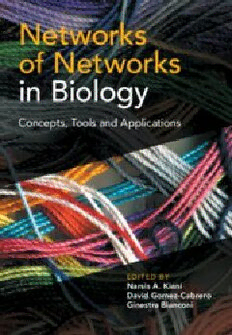
Networks of Networks in Biology: Concepts, Tools and Applications PDF
Preview Networks of Networks in Biology: Concepts, Tools and Applications
Networks of Networks in Biology Concepts,ToolsandApplications Biologicalsystemsareextremelycomplexandhaveemergentpropertiesthatcannot be explained or even predicted by studying their individual parts in isolation. The reductionist approach, although successful in the early days of molecular biology, underestimates this complexity. As the amount of available data grows, so it will become increasingly important to be able to analyse and integrate these large data sets.Thisbookintroducesnovelapproachesandsolutionstothebigdataproblemin biomedicine, and presents new techniques in the field of graph theory for handling and processing multi-type large data sets. By discussing cutting-edge problems and techniques, researchers from a wide range of fields will gain insights into how to exploit big, heterogeneous data in the life sciences through the concept of ‘network ofnetworks’. Narsis A. Kiani is Assistant Professor and Co-leader of Algorithmic Dynamics in the Department of Oncology-Pathology of the Karolinska Institutet, Sweden. She is passionateaboutmathematicsandisinterestedinthefundamentalquestionofwhat observationsabout effects at the microscopic level can tell us about the macroscopic natureofbiologicalsystemsandviceversa,andhowdefectsanddisorderaffectthese systems. David Gomez-Cabrero is the Head of the Translational Bioinformatics Unit at Navarrabiomed, Spain. Since 2009, he has specialized in bioinformatics and data integrationanalysis,firstasapost-doctorateandsubsequentlyasAssistantProfessor attheKarolinskaInstitutet,Sweden,andasSeniorLectureratKing’sCollegeLondon, UK.Hecollaborateswithclinicalgroupsthatinvestigatemultiplesclerosis,rheuma- toidarthritis,chronicobstructivepulmonarydisease(COPD)andcancer,amongother diseases. GinestraBianconiisProfessorofAppliedMathematicsatQueenMaryUniversityof London and a Turing Fellow at The Alan Turing Institute. She is Editor-in-Chief of theJournalofPhysics:ComplexityandEditorofScientificReportsandPLoSOne.Shehas publishedmorethan150articlesinnetworktheoryandinterdisciplinaryapplications, andistheauthorofthebookMultilayerNetworks:StructureandFunction. Networks of Networks in Biology Concepts, Tools and Applications Editedby NARSIS A. KIANI KarolinskaInstitutet,Stockholm DAVID GOMEZ-CABRERO King’sCollegeLondon GINESTRA BIANCONI QueenMaryUniversityofLondon TheAlanTuringInstitute UniversityPrintingHouse,CambridgeCB28BS,UnitedKingdom OneLibertyPlaza,20thFloor,NewYork,NY10006,USA 477WilliamstownRoad,PortMelbourne,VIC3207,Australia 314321,3rdFloor,Plot3,SplendorForum,JasolaDistrictCentre,NewDelhi 110025,India 79AnsonRoad,#06–04/06,Singapore079906 CambridgeUniversityPressispartoftheUniversityofCambridge. ItfurtherstheUniversity’smissionbydisseminatingknowledgeinthepursuitof education,learning,andresearchatthehighestinternationallevelsofexcellence. www.cambridge.org Informationonthistitle:www.cambridge.org/9781108428873 DOI:10.1017/9781108553711 ©CambridgeUniversityPress2021 Thispublicationisincopyright.Subjecttostatutoryexception andtotheprovisionsofrelevantcollectivelicensingagreements, noreproductionofanypartmaytakeplacewithoutthewritten permissionofCambridgeUniversityPress. Firstpublished2021 PrintedintheUnitedKingdombyTJBooksLimited,PadstowCornwall AcataloguerecordforthispublicationisavailablefromtheBritishLibrary. ISBN978-1-108-42887-3Hardback CambridgeUniversityPresshasnoresponsibilityforthepersistenceoraccuracy ofURLsforexternalorthird-partyinternetwebsitesreferredtointhispublication anddoesnotguaranteethatanycontentonsuchwebsitesis,orwillremain, accurateorappropriate. Contents ListofContributors page vii Preface ix PartI NetworksinBiology 1 1 AnIntroductiontoBiologicalNetworks 3 NuriaPlanell,XabierMartinezdeMorentinandDavidGomez-Cabrero 2 GraphTheory 18 AkramDehnokhalajiandNasimNasrabadi PartII NetworkAnalysis 33 3 StructuralAnalysisofBiologicalNetworks 35 NarsisA.KianiandMikkoKivela¨ 4 NetworksfromanInformation-TheoreticandAlgorithmic ComplexityPerspective 56 HectorZenilandNarsisA.Kiani 5 IntegrationandFeatureIdentificationinMulti-layerNetworksusingaHeat DiffusionApproach 71 GordonBallandJesperTegne´r PartIII Multi-layerNetworks 83 6 MultiplexNetworks 85 GinestraBianconi 7 ExistingToolsforAnalysisofMulti-layerNetworks 105 MassimoStellaandManlioDeDomenico 8 DynamicsonMulti-layerNetworks 121 ManlioDeDomenicoandMassimoStella PartIV Applications 145 9 TheNetworkofNetworksInvolvedinHumanDisease 147 CelineSinandJo¨rgMenche 10 TowardsaMulti-layerNetworkAnalysisofDisease:Challengesand OpportunitiesThroughtheLensofMultipleSclerosis 172 JesperTegne´r,IngridKockum,MikaGustafssonand DavidGomez-Cabrero v vi CONTENTS 11 Microbiome:AMulti-layerNetworkViewisRequired 183 RodrigoBacigalupe,SaeedShoaieandDavidGomez-Cabrero PartV Conclusion 195 12 ConcludingRemarks:OpenQuestionsandChallenges 197 GinestraBianconi,DavidGomez-Cabrero,JesperTegne´r andNarsisA.Kiani Index 201 Contributors RodrigoBacigalupeVIB-KULeuvenCenterforMicrobiology,CampusGasthuisberg, RegaInstituut,Leuven,Belgium GordonBallUnitofComputationalMedicine,DepartmentofMedicineSolna,Center forMolecularMedicine,KarolinskaInstitutet,Stockholm,Sweden(formermember) GinestraBianconiSchoolofMathematicalSciences,QueenMaryUniversityofLon- don,London,UK;TheAlanTuringInstitute,London,UK AkramDehnokhalajiOperationsandInformationManagementDepartment,Aston BusinessSchool,Birmingham,UK ManlioDeDomenicoFondazioneBrunoKessler,Povo,Italy DavidGomez-CabreroTranslationalBioinformaticsUnit,Navarrabiomed,Complejo Hospitalario de Navarra (CHN), Universidad Pu´blica de Navarra (UPNA), IdiSNA, Pamplona, Spain; Mucosal and Salivary Biology Division, King’s College London DentalInstitute,London,UK;UnitofComputationalMedicine,CenterforMolecular Medicine,DepartmentofMedicineSolna,KarolinskaInstitutet,KarolinskaUniversity HospitalandScienceforLifeLaboratory,Stockholm,Sweden MikaGustafssonDepartmentofPhysics,ChemistryandBiology(IFM)Bioinformat- ics(BION),Linko¨pingUniversity,Linko¨ping,Sweden NarsisA.KianiAlgorithmicDynamicsLab,UnitofComputationalMedicine,Depart- mentofOncology-Pathology,CentreforMolecularMedicine,KarolinskaInstituteand SciLifeLab,Stockholm,Sweden;AlgorithmicNatureGroup,LABORESfortheNatural andDigitalSciences,Paris,France MikkoKivela¨ DepartmentofComputerScience,SchoolofScience,AaltoUniversity, Finland Ingrid Kockum Department of Clinical Neuroscience and Center for Molecular Medicine,KarolinskaInstitute,KarolinskaUniversityHospital,Stockholm,Sweden Xabier Martinez de Morentin Translational Bioinformatics Unit, Navarrabiomed, ComplejoHospitalariodeNavarra(CHN),UniversidadPu´blicadeNavarra(UPNA), IdiSNA,Pamplona,Spain Jo¨rgMencheCeMMResearchCenterforMolecularMedicineoftheAustrianAcademy ofSciences,Vienna,Austria NasimNasrabadiDepartmentofMathematics,UniversityofBirjand,Iran Nuria Planell Translational Bioinformatics Unit, Navarrabiomed, Complejo Hospi- talario de Navarra (CHN), Universidad Pu´blica de Navarra (UPNA), IdiSNA, Pam- plona,Spain vii viii LIST OF CONTRIBUTORS SaeedShoaieCentreforHost–MicrobiomeInteractions,FacultyofDentistry,Oral& Craniofacial Sciences, King’s College London, London, UK; Science for Life Labora- tory,KTH–RoyalInstituteofTechnology,Stockholm,Sweden CelineSinCeMMResearchCenterforMolecularMedicineoftheAustrianAcademy ofSciences,Vienna,Austria MassimoStellaFondazioneBrunoKessler,Povo,Italy JesperTegne´rBiologicalandEnvironmentalSciencesandEngineeringDivision,Com- puter,ElectricalandMathematicalSciencesandEngineeringDivision,KingAbdullah UniversityofScienceandTechnology(KAUST),Thuwal,SaudiArabia;UnitofCom- putationalMedicine,CenterforMolecularMedicine,DepartmentofMedicineSolna, KarolinskaInstitutet,KarolinskaUniversityHospitalandScienceforLifeLaboratory, Stockholm,Sweden HectorZenilAlgorithmicDynamicsLab,DepartmentofOncology-Pathology,Centre forMolecularMedicine,KarolinskaInstitute,Stockholm,Sweden;AlgorithmicNature Group,LABORESfortheNaturalandDigitalSciences,Paris,France Preface NetworkScienceistransformingresearchindifferentareasoflivingsciences,ranging from evolutionary biologyto medicine.Thisbook aimstointroducethemostrecent developments of Network Science and its biological applications. In particular, the architecture of biological systems will be characterized using both single networks (monoplexes) and networks of networks (multi-layer networks). Graph theory and social network analysis are classic subjects of mathematics and sociology that have beenwidelyinvestigatedinthetwentiethcentury.However,onlysincethelate1990s, whenseveralpapersonthefundamentaldesignprinciplesofvariouskindsoflarge- scale networks were published, was Network Science established as a novel frame- worktoanalyseinteractingsystems,whichledtotheexpansionoftheresearchfield ofnetworkanalysis,withgreatimpactinbiology. After20years,thisfieldisstillproliferating,andithasbecomeincreasinglyclear thatthechallengeofintegratingandmodellingheterogeneityandcomplexityofliving systemscannotbeaddressedbyusingasingle-layernetwork(monoplex). Instead,thecomplexityoflivingsystems–suchastheinteractionsbetweenpro- teins and the microbiome – is captured by a multi-layer network approach. Multi- layernetworksareformedbynodesandinteractionsofdifferentnatures,andconno- tations, forming different networks that interact with each other, creating a network ofnetworks.Theinvestigationofmulti-layernetworksisaveryactiveresearcharea inNetworkScience,whichinthelasttenyearshasledtothedevelopmentofseveral methodologiestoextractinformationforanalysinglargedatasetsandintegratingthe resultsfromdifferentexperiments. With contributions from key leaders, this book discusses topics in Network Sci- ence that are increasingly foundational for the quantitative understanding of living systems.Furthermore,itconsolidatesexistingpracticalandtheoreticalknowledgeof bothmonoplexesandmulti-layernetworks.Thebookbalancesapplicationandtheory togive a unified overview of thisinterdisciplinary science.It is intendedto serve as an introductory text for graduate students and researchers in physics, biology, and biochemistry,andpresentsideasandtechniquesfromfieldsoutsidethereader’sown areaofspecialization. Aims of this Book Thisbookfocusesonnetwork-inspiredapproachesfortheanalysisandintegrationof thelargedatasetscurrentlyprevalentinlifesciences.Theprincipalaimofthiswork is to give a comprehensive overview of new techniques in the field of graph theory forhandlingandprocessingmulti-typelargedatasets.Bydiscussingstate-of-the-art problemsandtechniques,thisbookoffersresearchersfromawiderangeofareasthe uniqueopportunitytogaininsightsforexploitingtherichnessoflifesciencesdatasets through the concept of ’networks of networks’. It presents a timely, multi-authored compendium representing a diverse set of backgrounds and methods developed in ix
